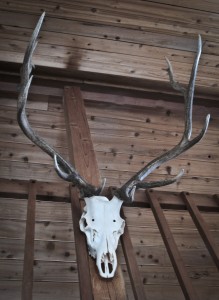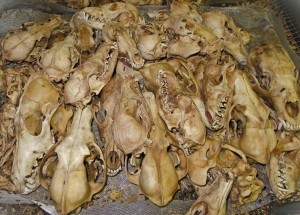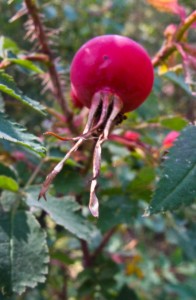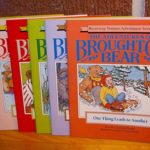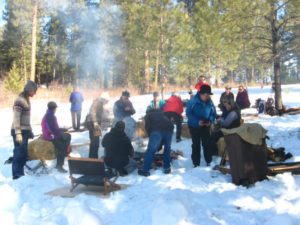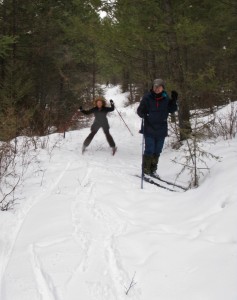 Another annual cookout at the homestead and as usual there were plenty of creative ideas for outdoor cooking. We began the day with a snowshoe trek up to the saddle and down the south side, looking for tracks and other sign. A few brave souls tried skiing on the crusty snow and got a bit of thrill careening down the narrow old road with tree hazards strategically placed. The upper meadow was smooth as white paper and for once we humans were the ones who left the story of our passing for other creatures to find.
Another annual cookout at the homestead and as usual there were plenty of creative ideas for outdoor cooking. We began the day with a snowshoe trek up to the saddle and down the south side, looking for tracks and other sign. A few brave souls tried skiing on the crusty snow and got a bit of thrill careening down the narrow old road with tree hazards strategically placed. The upper meadow was smooth as white paper and for once we humans were the ones who left the story of our passing for other creatures to find.
While we were skiing my son and his friend Grant, newly returned from Namibia where he’d spent two years in the peace corps, built a fire and got the tea water started. Grant mixed up a batch of barbeque biscuits and had the dough slowly rising by the side of the fire.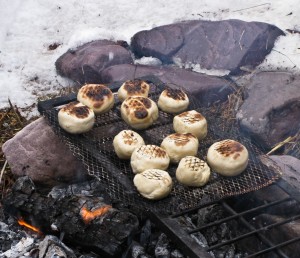
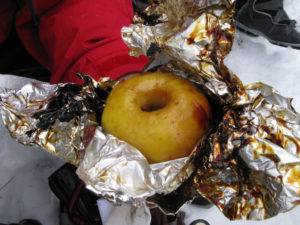 Packets of succulent concoctions simmering away soon covered the grill and coals. The usual mixed- grill dishes of meat and veggies in various combinations were the main course, but the deserts were what intrigued me. Judy made a baked apple, filling the cored center with brown sugar and cinnamon. Sharon split a banana lengthwise with the skin still on, then filled the center with peanut butter cups and melted it all slowly at the edge of the coals. Grant’s biscuits were slow to cook in the cold temperatures, but the crusty outsides and warm fluffy innards were delicious. When we are finished I threw Sharon’s banana peel on the fire and listened to it sing.
Packets of succulent concoctions simmering away soon covered the grill and coals. The usual mixed- grill dishes of meat and veggies in various combinations were the main course, but the deserts were what intrigued me. Judy made a baked apple, filling the cored center with brown sugar and cinnamon. Sharon split a banana lengthwise with the skin still on, then filled the center with peanut butter cups and melted it all slowly at the edge of the coals. Grant’s biscuits were slow to cook in the cold temperatures, but the crusty outsides and warm fluffy innards were delicious. When we are finished I threw Sharon’s banana peel on the fire and listened to it sing.
Looking forward to next year, I happened upon a great cookbook on a recent trip through Ennis. Titled Over a Fire: Cooking with a Stick and Cooking Hobo Style, it is filled with intriguing ideas and campfire lore. I’m planning to try the Fry Brownies made in hobo skillet. Check it out:
Fry Brownies
Before leaving home, stir together I cup flour, ¼ cocoa power, ¼ cup sugar, 1 tsp. baking powder, ¼ tsp. salt and 2 tbls. Nonfat dry milk. Add chocolate chips and walnuts if desired. Divide mixture among six zippered plastic bags, placing ½ cup of mix in each bag. Each bag will make 1 serving.
To prepare brownies, create a flat foil skillet. Find a sturdy Y-shaped forked stick and cut off the forked ends to matching lengths, 4” to 8” long. Cut two pieces of heavy- duty foil, extending 3” beyond the edges of the fork in all directions. Wrap foil tightly around the fork and joint. Use the skillet on a grate or tin can stove. (A portable frying pan was sometimes called a “banjo” in hobo terms.)
Place the pan over medium low coals or embers. To one bag of prepared brownie mix, add 1 teaspoon of vegetable oil and 1 ½ tbls. Water; knead mixture in bag until blended. Heat 1 tsp. oil in skillet. Cut off a large piece from one corner of plastic bag and squeeze spoon-sized mounds of brownie batter into hot skillet. Cook until bottoms are browned and tops are no longer shiny. Flip brownies over, flatten as needed and cook until other side is lightly browned. Let cool before serving.

